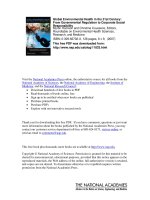Psychology applied to modern life adjustment in the 21st century, 11e chapter 16
Bạn đang xem bản rút gọn của tài liệu. Xem và tải ngay bản đầy đủ của tài liệu tại đây (585.86 KB, 42 trang )
Chapter 16
Positive Psychology
The Scope of Positive Psychology, continued
Defining positive psychology and its brief history
•
Positive psychology – “is a social and intellectual movement within the
discipline of psychology that focuses on human strengths and how people can
flourish and be successful”.
The Scope of Positive Psychology, continued
History, continued
•
Identified in 1998 by Martin Seligman, positive psychology serves as a
counterweight to the field’s negatively-oriented history.
–
Since WWII, psychology has adhered to the “disease model” to treat stress
and disorders associated with the modern world.
–
Seligman argues people should learn to see their lives as fulfilling, rather than
stress-ridden and dysfunctional.
The Scope of Positive Psychology, continued
Reconsidering older research in light of the new positive psychology
•
•
Positive psychology does represent a turning point for the field
However, many of the main ideas are similar those of humanistic psychology,
which has been present since the 1950s.
The Scope of Positive Psychology, continued
Introducing positive psychology’s three lines of inquiry
•
Positive psychology pursues three main “legs” on which the field stands:
1.
2.
3.
Positive subjective experiences (good moods, happiness, and love).
Positive individual traits (character strengths and virtues).
Positive institutions (families, schools, & supportive work environments).
Figure 16.1. The three legs of positive psychology. Research in positive psychology stands on “three legs” or lines of empirical, scientific inquiry: positive subjective experiences,
positive individual traits, and positive institutions.
Positive Subjective Experiences, continued
Positive moods
•
•
Moods are “global, pervasive responses to experiences”.
Being in a good mood has several beneficial effects, including
•
•
•
Making people more agreeable.
Making people more helpful.
Making people better decision-makers.
Positive Subjective Experiences, continued
Positive moods, continued
•
Positive moods can promote creative solutions
•
Isen et al (1987) found that participants who watched a funny film were better
able to solve the “candle task” (see Figure 16.2).
Positive Subjective Experiences, continued
Positive moods are linked with quick thoughts
•
Faster thinking is associated with more positive mood, whereas slower thinking is
associated with more negative mood (Pronin, Jacobs, and Wegner,2008).
•
•
See Figure 16.4 for study details.
Variability of thought also affects mood.
•
Varied thoughts are associated with positive mood; repetitive thoughts are
associated with negative mood.
Figure 16.4. Results of the self-generated ideas, speed of thought, and mood experiment. Participants in the fast-thinking condition of the experiment generated more ideas in the
allotted time than did their peers (see the graph on the far left). And as expected, the fast-thinkers also reported thinking faster than those in the slow-thinking group. The crucial results
are shown in the two graphs on the right. As you can see, those in the fast-thinking group also reported having a more positive mood and high levels of energy than those in the slowthinking group.
Adapted from Pronin, E., & Jacobs, E. (2008). Thought speed, mood, and the experience of mental motion. Perspectives on Psychological Science, 3, 461-485, Figure 3.
Positive Subjective Experiences, continued
Positive emotions
•
Emotions – “are powerful, largely uncontrollable feelings, accompanied by
physiological changes”.
•
Positive emotions – “consist of pleasant responses to events that promote
connections with others, including subjective states like happiness, joy, euphoria,
gratitude, or contentment”.
Positive Subjective Experiences, continued
Positive emotions, continued.
•
Negative emotions – “consist of unpleasant responses to potential threats or
dangers, including subjective states like sadness, disgust, anger, guilt, and fear”.
•
Historically, negative emotions have been studied more than positive ones
because
•
•
•
They are of evolutionary significance.
They are part of the “fight-or-flight” response.
There are so many of them.
Positive Subjective Experiences, continued
Positive emotions, continued
•
Barbara Fredrickson developed the broaden-and-build model of positive
emotions to explain how they benefit us.
•
Positive emotions
•
Elicit nonspecific action tendencies that lead to adaptive responses (e.g.,
helping people in need when we are happy).
•
Broaden cognitive processes by promoting thought-action tendencies (e.g.
children become imaginative when feeling joy).
Positive Subjective Experiences, continued
Positive emotions, continued.
•
Fredrickson an Branigan (2005) showed that joy increased participants’ thoughtaction tendencies (see Figure 16.5).
•
Thus, “the broaden-and-build model proposes than positive emotions broaden
people’s outlooks and then builds on subsequent learning in order to develop
future emotional and intellectual resources”.
Figure 16.5. The broadening effects of positive emotions compared to neutral or negative emotions. Experiencing an emotional state of joy or contentment led research
participants to list a greater number of activities they might like to engage in at that moment in time compared to individuals experiencing a neutral or negative emotional state.
Adapted from Fredrickson, B. L. (2002). Positive emotions. In C. R. Snyder & S. J. Lopez (Eds.), Handbook of positive psychology (pp. 120-134). New York: Oxford University
Press, Figure 9.2, p. 125.
Positive Subjective Experiences, continued
Positive emotions, continued
•
Fredrickson has developed the undoing hypothesis, which posits that “positive
emotions aid the mind and the body by recovering a sense of balance and
flexibility following an episode experiencing negative emotion”.
•
When stressed, positive emotions undo the aftereffects of the stressor more
quickly, for example.
Positive Subjective Experiences, continued
Flow
•
Flow – “the state of being wherein a person becomes fully involved and engage in
the present time by some interesting, challenging, and intrinsically rewarding
activity”.
•
When in this state, people become
•
•
Less self-aware and lose all track of time.
Focus all their energies and attention on an activity where skill and challenge
are in balance.
Positive Subjective Experiences, continued
Flow, continued
•
Finding flow
•
According to Csikszentmihalyi, we find flow when engaged in activities that
have the ideal balance of challenge and skill level (see Figure 16.8).
•
Once these criteria are met, the activity becomes intrinsically rewarding,
produces positive emotions, and promotes goal attainment and achievement.
Figure 16.8. The revised model of flow state. According to the revised model, flow is experienced when a person’s perceived challenges and skills are above the person’s average
levels; when they fall below, the individual experiences apathy. The intensity of the experience increases as the distance from the person’s average levels of challenge and skills grows
greater (illustrated here by the concentric rings).
Adapted from Csikszentmihalyi, M. (1997). Finding flow. New York: Basic Books.
Positive Subjective Experiences, continued
Flow, continued
•
Does everyone find flow?
•
Csikszentmihalyi finds that about 20% of respondents in American and
European samples say they experience flow several times a day.
•
Around 15% have never reported this experience.
Positive Subjective Experiences, continued
Mindfulness
•
Mindfulness – refers “to a cultivated perspective wherein people are sensitive to
context and focused on the present”.
•
When mindful, we
•
•
•
Resist the impulse to control uncertainty.
Are less prone to evaluate ourselves.
Are in a more flexible state of mind.
Positive Subjective Experiences, continued
Mindfulness, continued
•
We can become more mindful by
•
Meditating (especially if attention is directed in a nonanalytical and
nonemotional way).
•
See Figure 16.9 for a list of mindfulness qualities that can enter one’s
consciousness during meditation.
•
Experiencing natural surroundings.
Figure 16.9. Some qualities associated with mindfulness meditation. People who learn mindfulness meditation can expect to derive some benefits from the activity. As you can
see, the qualities listed here that are associated with mindfulness meditation fit well with established themes in positive psychology.
Adapted from Shapiro, S. J., Schwartz, G. E. R., & Santerre, C. (2002). Meditation and positive psychology. In C. R. Snyder & S. J. Lopez (Eds.), The handbook of positive
psychology (pp. 632-645). New York: Oxford University Press. Table 46.1, p. 640.
Positive Individual Traits, continued
Positive individual traits “refer to dispositional qualities that account for why some
people are happier and psychologically healthier than other people”.
•
Four traits have been the focus of much study:
1.
2.
3.
4.
Hope.
Resilience.
Gratitude.
Spirituality.
Positive Individual Traits, continued
Hope: achieving future goals
•
Hope is “people’s expectations that their goals can be achieved in the future”.
•
Synder argues it has two components:
1.
2.
•
Agency – “a person’s judgment that his or her goals can be achieved”.
Pathways – “realistic roadmaps to achieving the goal”.
The Trait Hope Scale assesses each and indicates a person’s degree of hope
(see Figure 16.10).









